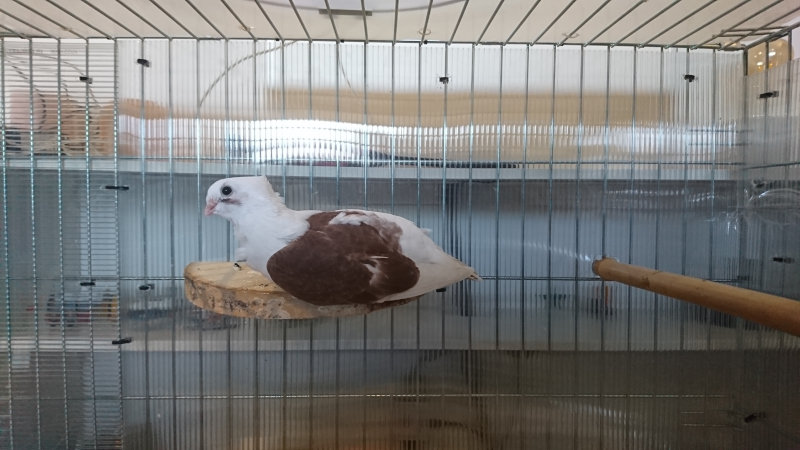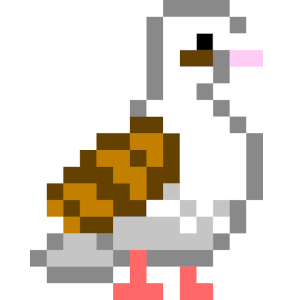reminder: All articles and posts on my website are written by me and from my own perspective (Sophie The Pigeon) and often I'm typing it aimed at other birds 😉
Hygiene (Cage)
In this article I will discuss some important aspects about cage hygiene, and give some other hygiene tips in regards to keeping us pigeons as pets in your home.
(Daily) Hygiene Routine
For the daily hygiene routine it is (very) important that you change (replace) the cage bedding every day. If your pigeon(s) have a ‘bed’ (perch they sleep on), then make sure that you also check this perch for droppings (poop) and clean it every day (you would not want a dirty bed either 😉 ).
Next to replacing the bedding every day, you should also thoroughly clean the drinking and food bowl/dishes daily. You should rinse our food and water bowl/dishes daily with hot water at a minimum, and frequently clean them with a non toxic disinfectant soap and hot water. Of course you will need to make sure that they are rinsed thoroughly with fresh water afterwards so that there will be no cleaning solution residue when we use them to eat or drink from.
What type of food and drinking bowl/dishes to use
Me and my pet humans would recommend using (glazed) ceramic, (strong thick) glass or (non toxic) metal dishes or bowls. Simply because these can be easily cleaned (and often even be put in the dishwasher), and with these materials it is nearly impossible to give bacteria a chance to grow on them.
DISHWASHER WARNING: IF you use a dishwasher to clean your bird bowls/dishes (we don’t), then do make sure that the dishwasher cleaning solution doesn’t leave any residue on the bowls/dishes. Especially those ‘shine solutions’ can leave a ‘strange residue’ on the bowls and dishes. Just don’t take any risk with such cleaning solutions when it comes to us birds.
What type of perches (‘beds’) to use
Depending on your cage, how it’s build and your ‘personal touch’ to the entire setup, you can have different type of ‘beds’ for your pet pigeon(s). The cage itself can for example have it’s own ‘build-in extra floors’, but you can also add your own perches like shown here in this (older) photo of my bedroom cage (ignore the round perch, it has a different purpose):

If you install your own perches (which are often made of wood), then it is very important that you make sure that they are not made out of toxic wood.
You should not use perches or perch/’bed’ materials which can easily house bacteria and such. Some examples of this would be: fluffy blankets, towels, happy huts and more of the alike. Not only will these materials be a ‘great place’ for bacteria to grow, they can also be quite dangerous if we birds start chewing on them and ingest parts of it. There are unfortunately a lot of stories known about pet birds which have died due to impaction and even choking on parts of such ‘beds’. Just use (safe non toxic) wooden perches.
For us pigeons it is also important that you use flat perches (like shown in my photo) where we can sleep on. We pigeons prefer to sleep on flat surfaces.
One downside to using wooden perches (like mine), is that they will have a larger risk to house bacteria (compared to for example plastic or metal perches which are already build into the cage). This also means that you will have to (thoroughly) clean our perches and even replace them every now and then to ensure that it won’t turn into a bacteria breeding ground.
|
Advertisement blocked due to cookie settings.
Please consider reading my AdSense Information page to learn why I use advertisments on my website and how you can enable them. The AdSense Information page also explains that and how I'm telling Google/AdSense to only show non personalized / non tracking advertisements. |
Weekly Hygiene routine
Next to the daily cleaning you should also (at a minimum) clean our cage(s) thoroughly. My pet humans use the following routine to clean my cage(s) (at least) weekly:
- First they will remove all (news paper) bedding
- Then they will vacuum the entire cage thoroughly (to remove all feather dust and ‘pin feather remains’ for example)
- Then they will clean the cage with a vinegar solution (ratio 1:1)
- Then they will dry the entire cage with paper towels
- Then they will clean the cage again with fresh water (no mixture) to get rid of any ‘vinegar residue’
Vinegar itself if a very popular cleaning solution when it comes to cleaning bird cages, it also easily softens hardened (missed on daily cleaning routine) droppings. The vinegar solution (in general and moderation) is not toxic to us birds if it did left a bit of residue, however we of course recommend to make sure that there isn’t any “cleaning agent” residue left behind in the cage.
Do not keep us birds in the same room while cleaning our cage
When you’re doing your weekly cleaning routine you will need to make sure that your pet pigeon(s) are not in the same room. Despite the fact that the vinegar solution isn’t toxic to us birds, our respiratory system is VERY sensitive to any and all vapors & fumes, so just make sure that you keep us birds away from them.
What if the cage, perch or toy so dirty that vinegar won’t work?
Well simply put: In our opinion: Replace it. Period, no discussion possible. This would mainly only happen if you (or the previous owner for example) have neglected to follow proper hygiene in the past.
But some websites recommend using bleach, chlorine or ammonia (solutions) for cleaning
Yes you are right, some website do recommend this, but we strongly advice against it. Not only are the fumes from bleach, chlorine or ammonia very bad and irritating for us birds, they can even be deadly.
Monthly Deep Cleaning Routine
The “monthly deep cleaning routine” is for my pet humans basically the same routine as the Weekly Hygiene routine, with some extra additions to it.
With the monthly deep cleaning they will pay even more attention to all crevices of the cage (using a toothbrush to cleanthe most narrow area’s for example), they will move the cages completely and very thoroughly clean the floor (carpet) underneath the cage, clean the (wooden) wall next to my cage with disinfectant and more of the alike.
You should kinda consider it like this: You keep your own house clean, and clean up after yourself daily, thoroughly clean it in the weekends for example and then once a month or every two/three months you do a thorough cleaning right? Well consider the ‘monthly deep cleaning routine’ as that ‘occasional thorough cleaning’ of your own home, but then just in and around our cage(s) 🙂
Replace toys or perches ‘semi-regularly’
Not sure if ‘semi-regularly’ is actually a real term 🤣, but what I mean with this is that you should basically replace toys made of rope (or fabric) every two to six months (preferably for the same toy if your pigeon(s) have a strong liking for them). To prevent that bacteria could start living deeper inside the rope/toy.
Obviously you would still need to clean these items regularly, but ‘full replacement’ of such items is highly recommended at the above mentioned interval(s). This ‘replacement’ interval also depends on how dirty the object gets, how much of a risk it is to house bacteria, how easy it is to clean (weekly) until it needs to be replaced and more of the alike. So the replacement interval of such objects/items should be done to your own assessment.
Same goes for wooden perches (like the one I’m sleeping on for example), these should also be replaced every now and then to prevent bacterial infestation on a ‘deeper level’ inside the material.
WE DO NOT recommend cleaning these items (such as the toys and perches) with bleach or so as an alternative to replacing them once in a while! Simply because such cleaning solutions and chemicals could easily be soaked into these items, and thus pose a serious risk of poisoning your pigeon(s) with it.
Cage rust, oxidation or paint chipping
If the cage of your pigeon(s) starts to rust, oxidate/oxidize or when paint/coating starts to chip off (no matter if it’s in reach of the pigeon(s) (yet)!), it is seriously time to just replace the cage! I/we understand this can be quite costly, but for most people goes: that they are most likely not qualified/skilled enough to truly safely repair the damage for the pigeon(s).
You should not want to take any risk in such situations, and just replace the cage instead of trying ‘DIY repairs’.
If you are a professional or highly experienced in such repairs, and do know what materials, coating or even paints can be used to safely restore the cage, then you can obviously just do so. But even then you should do such repairs as soon as possible (read: directly when noticing the damage).
